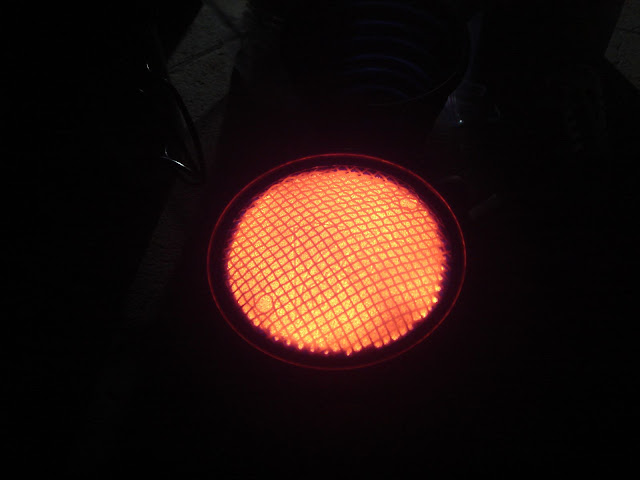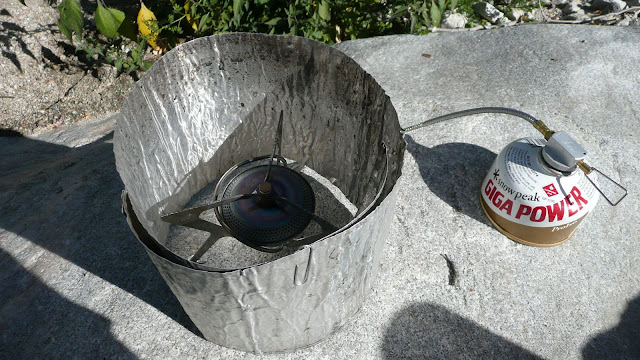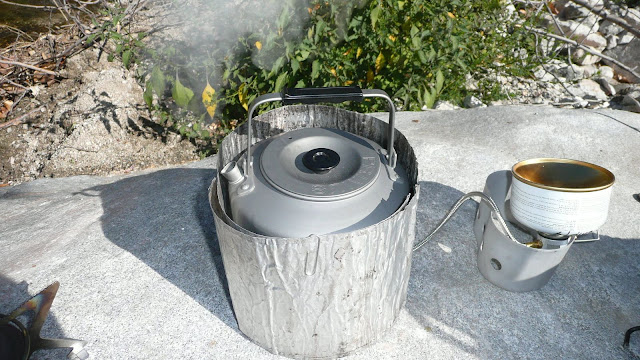Sometimes, technology can be brought to bear in ways that change the very game. So it is with the technology of the MSR Reactor.
Hail the inferno; this is the hottest stove out there. It boils water faster than anything else I've ever seen. It's not light, it's not cheap, but dang is it effective.
Let's take a look. Here's a Reactor all packed for travel. The handle locks across the clear lid holding everything securely.
Inside you can fit an 8oz/230g canister of gas, the burner, and a little bit more. I've got it wrapped here in a wash cloth just to prevent rattling. It could easily accommodate a spoon and a lighter. One pushes the "ball" on the left side of the handle. The handle springs up. One then unfolds the handle, like so:
I like the fact that the handle locks down, holding everything in place, but herein lies a vulnerability. The small piece of metal shown below is all that holds that handle in place.
Every time that handle is folded or unfolded, that small piece of metal has to bend. Repetitive bending of a metal = metal fatigue = failure. I've not heard of failures of this point, but they inevitably will come. How soon? I can't say, but I think this is a weakness in the design. Note: I don't mean to sound alarmist here. I don't think the handle will fail immediately. I think we're talking about years here not days or months.
Another nice feature, the burner nestles up inside a 8oz/230g sized gas canister.
OK, so it packs up nicely. Fine. But what the Dickens is all the buzz about? I'll tell you. HEAT, baby, heat.
The MSR Reactor is all about putting heat into whatever is in your pot. How does it do it? First, with a radiant heat burner. It burns fuel, but not in an open flame like a normal burner. Instead, the burner head is heated by the burning of gas and then heat is radiated into the pot. The radiant heat burner:
Heat is transferred first by a fairly tight nesting of the burner underneath the pot.
And then by an integral heat exchanger
Wind? Not a problem. When the pot is mounted on the burner, you can't even see the burner.
Heat flows from the burner to the heat exchanger into the pot. Any exhaust heat is forced up along the sides of the pot until it reaches the vents seen in the above photo, a process transferring yet even more heat to the contents of your pot while still being almost totally protected from the wind. In a 100 mph gale on top of an exposed plateau at 15,000' (4500m), this is the stove to have. Note also that I'm holding the burner at a steep angle. The pot doesn't budge. If you jostle your pot in tight quarters, no problem. Your pot -- and your supper -- are staying right where you put them. No tippy, slidey action here. Still, not a bad idea to put a set of "legs" under your canister if you've got 'em. The Brunton CanStand, Primus Foot Rest, and JetBoil tripod stabilizer all should fit an 8oz/230g sized canister. The JetBoil version is shown here.
Another nice feature? How about liquid measurement lines on the inside of the pot?
And don't forget the little pack towel they give you. I use it to protect the bottom of the burner -- and the bottom of the pot.
One caution: This is a seriously hot stove. A friend of mine walked away for a minute and got distracted. When he got back, the pot had not only boiled dry, it had melted. It's a dang good thing that his canister didn't overheat and explode. As it was, he lost his pot. He could have lost a whole lot more. This is a stove that you want to keep an eye on.
Well how about at the other end of the temperature range? What about simmering? Well, the Reactor quite frankly has a bad reputation in the simmering department. But lack of simmering is not a given with the Reactor. There are a lot of individual variations Reactor to Reactor, and some of them do simmer if you're patient and willing to fiddle with them. Here's a Reactor on low flame.
For a bit more on how to simmer, I'll refer you to this YouTube video that I put together.
Now, the question that is probably on every serious mountaineer's mind is, "how is it at melting snow?" It's great. It's super hot; it's wind proof; what more could you want?
Ah, but high tech though it is, it is still constrained by the laws of physics and therein the problem lies. This is an upright canister stove. On an upright canister stove, vaporized gas is fed to the burner where it is combusted, producing heat. In cold weather, gas doesn't vaporize very well. There are a lot of factors that control whether or not a given upright canister type stove will work well in cold weather (you can see some of my other blog posts for more about this) and a Reactor will do better than some, but high tech or no, there's a point at which your fuel simply will no longer vaporize. There are tricks you can employ like sleeping with the canister at night or carrying the canister inside your jacket by day and then using the first gas in the warm canister to heat up some water which is then placed in a spare pan into which you place the canister, but tricks like that can only take you so far. My working number is 20F/-7C. Below that, you begin to push your luck with an upright canister stove. For all its technology, the Reactor cannot escape the constraints of physics. Is it a good snow melter? Sure. Down to about 20F, maybe even a little lower. But somewhere around that temperature 20F, you run into a hard stop, a hard stop that the Reactor's technology simply cannot overcome.
Note: if you're a serious mountaineer and you're ascending to very high altitudes, you can operate a Reactor at lower temperatures than 20F. Gas will vaporize at a lower temperature at higher altitudes. But you'd better do your homework and understand just what the Reactor's temperature limitations will be for the altitude you'll be at. Guess wrong and you've got no stove. No stove = no water = dehydration which can lead to hypothermia which can lead to death.
Bottom line? This is a great stove, but in cold weather you'd better darn well know it's limitations.
Thanks for joining me on another adventure in stoving,
HJ
The MSR Reactor
What's good about it
Hot
Wind proof
Stable
Hot
Well thought out
Extremely functional
Hot
Packable
Reasonably Efficient (if you don't run it on high)
Hot
Can nest an 8oz/230g gas canister inside the pot.
Liquid measures delineated on inside of pot
Did I mention hot?
What's bad about it
Expensive
Heavy
Bulky
Can eat a lot of fuel if you run it on high
Limited by it's upright canister type to temperatures of about 20F.
Can be tough to simmer.
Hail the inferno; this is the hottest stove out there. It boils water faster than anything else I've ever seen. It's not light, it's not cheap, but dang is it effective.
Let's take a look. Here's a Reactor all packed for travel. The handle locks across the clear lid holding everything securely.
Inside you can fit an 8oz/230g canister of gas, the burner, and a little bit more. I've got it wrapped here in a wash cloth just to prevent rattling. It could easily accommodate a spoon and a lighter. One pushes the "ball" on the left side of the handle. The handle springs up. One then unfolds the handle, like so:
I like the fact that the handle locks down, holding everything in place, but herein lies a vulnerability. The small piece of metal shown below is all that holds that handle in place.
Every time that handle is folded or unfolded, that small piece of metal has to bend. Repetitive bending of a metal = metal fatigue = failure. I've not heard of failures of this point, but they inevitably will come. How soon? I can't say, but I think this is a weakness in the design. Note: I don't mean to sound alarmist here. I don't think the handle will fail immediately. I think we're talking about years here not days or months.
Another nice feature, the burner nestles up inside a 8oz/230g sized gas canister.
OK, so it packs up nicely. Fine. But what the Dickens is all the buzz about? I'll tell you. HEAT, baby, heat.
The MSR Reactor is all about putting heat into whatever is in your pot. How does it do it? First, with a radiant heat burner. It burns fuel, but not in an open flame like a normal burner. Instead, the burner head is heated by the burning of gas and then heat is radiated into the pot. The radiant heat burner:
Heat is transferred first by a fairly tight nesting of the burner underneath the pot.
And then by an integral heat exchanger
Wind? Not a problem. When the pot is mounted on the burner, you can't even see the burner.
Heat flows from the burner to the heat exchanger into the pot. Any exhaust heat is forced up along the sides of the pot until it reaches the vents seen in the above photo, a process transferring yet even more heat to the contents of your pot while still being almost totally protected from the wind. In a 100 mph gale on top of an exposed plateau at 15,000' (4500m), this is the stove to have. Note also that I'm holding the burner at a steep angle. The pot doesn't budge. If you jostle your pot in tight quarters, no problem. Your pot -- and your supper -- are staying right where you put them. No tippy, slidey action here. Still, not a bad idea to put a set of "legs" under your canister if you've got 'em. The Brunton CanStand, Primus Foot Rest, and JetBoil tripod stabilizer all should fit an 8oz/230g sized canister. The JetBoil version is shown here.
Another nice feature? How about liquid measurement lines on the inside of the pot?
And don't forget the little pack towel they give you. I use it to protect the bottom of the burner -- and the bottom of the pot.
One caution: This is a seriously hot stove. A friend of mine walked away for a minute and got distracted. When he got back, the pot had not only boiled dry, it had melted. It's a dang good thing that his canister didn't overheat and explode. As it was, he lost his pot. He could have lost a whole lot more. This is a stove that you want to keep an eye on.
Well how about at the other end of the temperature range? What about simmering? Well, the Reactor quite frankly has a bad reputation in the simmering department. But lack of simmering is not a given with the Reactor. There are a lot of individual variations Reactor to Reactor, and some of them do simmer if you're patient and willing to fiddle with them. Here's a Reactor on low flame.
For a bit more on how to simmer, I'll refer you to this YouTube video that I put together.
Now, the question that is probably on every serious mountaineer's mind is, "how is it at melting snow?" It's great. It's super hot; it's wind proof; what more could you want?
Ah, but high tech though it is, it is still constrained by the laws of physics and therein the problem lies. This is an upright canister stove. On an upright canister stove, vaporized gas is fed to the burner where it is combusted, producing heat. In cold weather, gas doesn't vaporize very well. There are a lot of factors that control whether or not a given upright canister type stove will work well in cold weather (you can see some of my other blog posts for more about this) and a Reactor will do better than some, but high tech or no, there's a point at which your fuel simply will no longer vaporize. There are tricks you can employ like sleeping with the canister at night or carrying the canister inside your jacket by day and then using the first gas in the warm canister to heat up some water which is then placed in a spare pan into which you place the canister, but tricks like that can only take you so far. My working number is 20F/-7C. Below that, you begin to push your luck with an upright canister stove. For all its technology, the Reactor cannot escape the constraints of physics. Is it a good snow melter? Sure. Down to about 20F, maybe even a little lower. But somewhere around that temperature 20F, you run into a hard stop, a hard stop that the Reactor's technology simply cannot overcome.
Note: if you're a serious mountaineer and you're ascending to very high altitudes, you can operate a Reactor at lower temperatures than 20F. Gas will vaporize at a lower temperature at higher altitudes. But you'd better do your homework and understand just what the Reactor's temperature limitations will be for the altitude you'll be at. Guess wrong and you've got no stove. No stove = no water = dehydration which can lead to hypothermia which can lead to death.
Bottom line? This is a great stove, but in cold weather you'd better darn well know it's limitations.
Thanks for joining me on another adventure in stoving,
HJ
The MSR Reactor
What's good about it
Hot
Wind proof
Stable
Hot
Well thought out
Extremely functional
Hot
Packable
Reasonably Efficient (if you don't run it on high)
Hot
Can nest an 8oz/230g gas canister inside the pot.
Liquid measures delineated on inside of pot
Did I mention hot?
What's bad about it
Expensive
Heavy
Bulky
Can eat a lot of fuel if you run it on high
Limited by it's upright canister type to temperatures of about 20F.
Can be tough to simmer.


















































